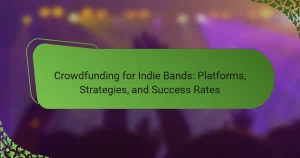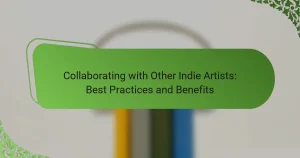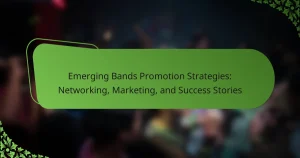Indie music festivals provide artists and fans with valuable opportunities for collaboration and exposure. These events facilitate networking among musicians, showcase talent to industry professionals, and celebrate diverse genres. Unique festival types, such as genre-specific and eco-friendly gatherings, enhance the experience for attendees. However, artists may face challenges like financial constraints and competition for visibility, impacting their ability to connect and grow.
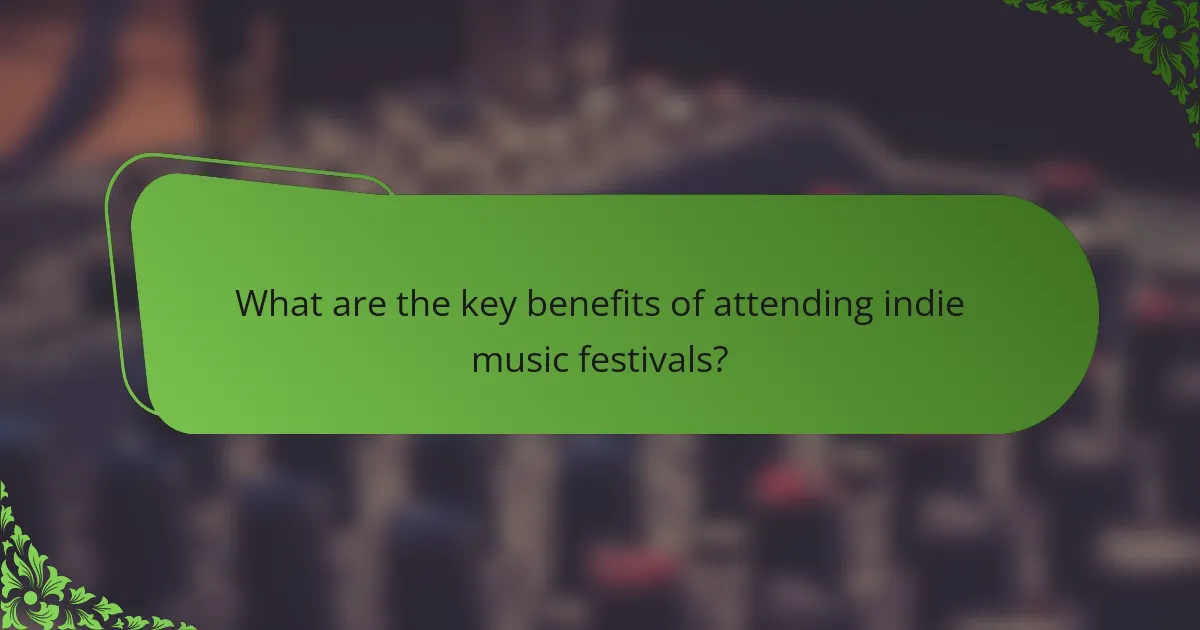
What are the key benefits of attending indie music festivals?
Attending indie music festivals offers significant benefits for artists and fans alike. These events provide unique opportunities for collaboration, networking, and exposure to diverse audiences.
Artists can showcase their talent to industry professionals, which can lead to potential record deals or collaborations. Festivals often feature a variety of genres, allowing artists to connect with like-minded musicians and expand their creative horizons.
For fans, indie music festivals create a vibrant atmosphere filled with live performances, workshops, and interactive experiences. Attendees can discover new artists and enjoy a sense of community that celebrates independent music.
Overall, indie music festivals serve as a crucial platform for growth and connection within the music industry.
How do indie music festivals foster collaboration among artists?
Indie music festivals foster collaboration among artists by providing a platform for networking and creative exchange. These events encourage artists to share ideas, collaborate on performances, and form partnerships. The diverse lineup often includes emerging talents and established acts, enhancing opportunities for mentorship and cross-genre experimentation. As a result, artists can develop unique collaborations that may not occur in traditional settings.
What exposure opportunities do indie music festivals provide for emerging artists?
Indie music festivals provide emerging artists with valuable exposure opportunities through live performances, networking, and collaboration. Artists can showcase their talent to diverse audiences and industry professionals, increasing their visibility. Festivals often feature workshops and panels, allowing artists to learn from established musicians and industry experts. Additionally, collaboration with other artists can lead to new creative partnerships and future opportunities.
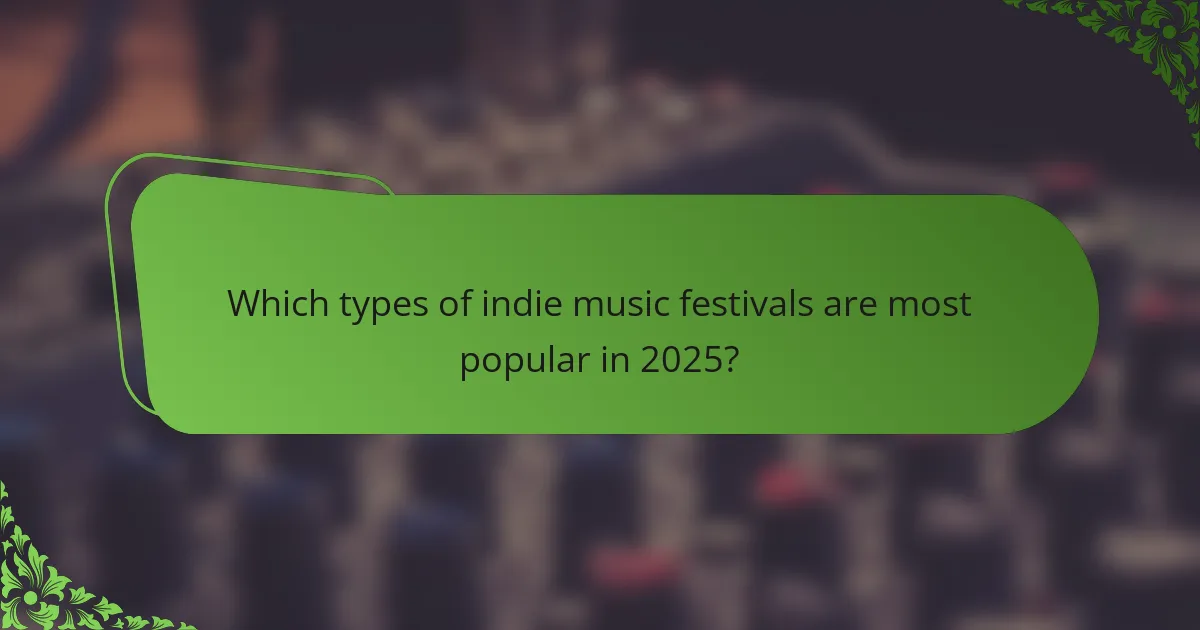
Which types of indie music festivals are most popular in 2025?
In 2025, the most popular types of indie music festivals include genre-specific events, urban festivals, and eco-friendly gatherings. Genre-specific festivals focus on particular music styles, attracting dedicated fans. Urban festivals take place in city settings, providing diverse experiences and accessibility. Eco-friendly gatherings emphasize sustainability, appealing to environmentally conscious attendees. Each type offers unique opportunities for collaboration and exposure among artists and fans.
What are the defining features of large-scale indie music festivals?
Large-scale indie music festivals feature diverse lineups, community engagement, and opportunities for collaboration. These festivals often showcase emerging artists alongside established acts, creating a platform for exposure. Attendees benefit from unique experiences, including workshops and interactive sessions. Furthermore, these events foster networking among artists, industry professionals, and fans, enhancing the indie music ecosystem.
How do local indie music festivals differ from national ones?
Local indie music festivals emphasize community engagement and collaboration, while national festivals focus on broader exposure and commercial success. Local festivals often feature emerging artists, fostering connections within the local music scene. They typically offer intimate settings, allowing for direct interaction between artists and attendees. National festivals, in contrast, attract larger crowds and more established acts, providing significant promotional opportunities but less personal engagement. These differences shape the experiences and opportunities available at each type of festival.

What challenges do artists face when participating in indie music festivals?
Artists face several challenges when participating in indie music festivals, including financial constraints, competition for visibility, and logistical issues. Many artists struggle with the costs associated with travel, accommodation, and festival fees. Additionally, the crowded lineup can make it difficult for emerging artists to stand out and attract an audience. Logistical challenges, such as equipment transport and technical setup, further complicate their participation. These factors can hinder collaboration and limit exposure opportunities at such events.
How can artists effectively navigate festival application processes?
Artists can navigate festival application processes by researching requirements, tailoring their submissions, and following up effectively. Begin by identifying festivals that align with your genre and audience. Carefully read application guidelines to ensure compliance. Customize your materials, such as press kits and bios, to highlight relevant experiences and unique attributes. Submitting high-quality recordings and visuals can enhance your chances. After applying, maintain communication with festival organizers to express interest and ask for updates. This proactive approach can lead to increased collaboration and exposure opportunities.
What logistical issues should artists consider when preparing for a festival?
Artists should consider several logistical issues when preparing for a festival. Key factors include transportation, equipment needs, accommodation, and scheduling.
Transportation involves planning for vehicle access and parking. Equipment needs require checking sound systems, instruments, and other gear. Accommodation should be arranged early to ensure availability. Scheduling includes coordinating performance times and rehearsals.
Additionally, understanding festival layout and crowd management can enhance performance. Collaborating with other artists can also create opportunities for exposure and networking.
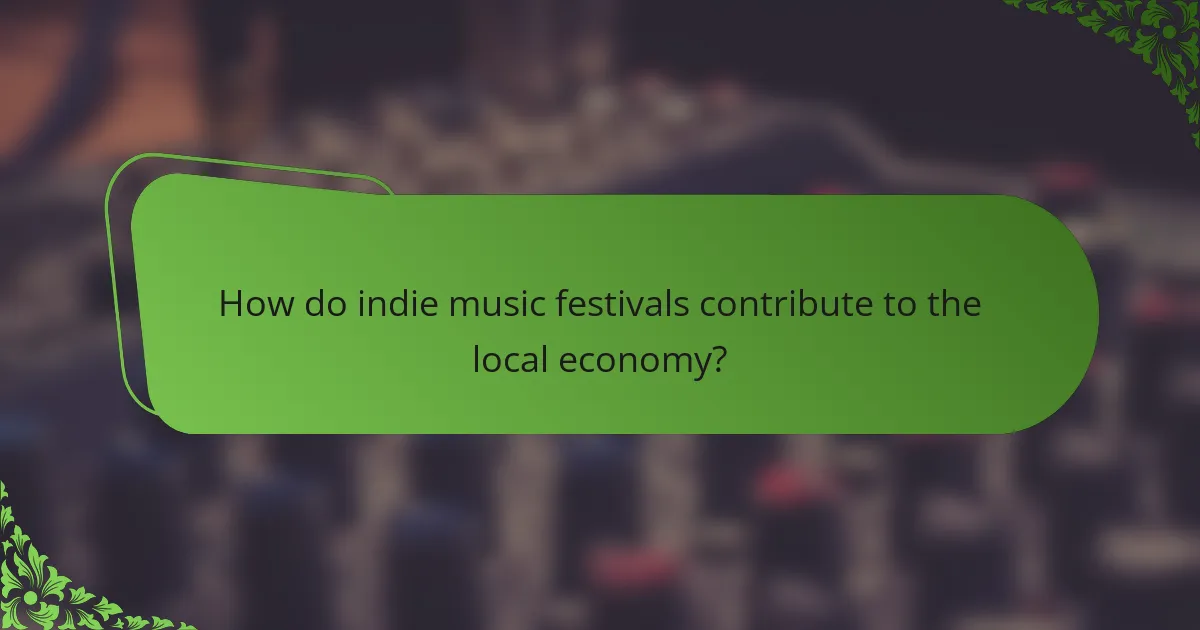
How do indie music festivals contribute to the local economy?
Indie music festivals significantly boost the local economy by attracting visitors and generating revenue. They create jobs, increase tourism, and support local businesses. For instance, a study found that festivals can generate millions in economic impact, benefiting hotels, restaurants, and vendors. Additionally, these events foster community engagement and cultural exchange, enhancing the area’s appeal.
What role do sponsors play in the success of indie music festivals?
Sponsors play a crucial role in the success of indie music festivals by providing essential funding and resources. They enhance visibility for both the festival and the artists, creating a mutually beneficial relationship. Sponsorships can cover costs for venue, promotions, and artist fees, which allows festivals to thrive. Additionally, sponsors often bring their audience, expanding the festival’s reach and potential for collaboration. This partnership fosters a vibrant community that supports emerging talent and promotes cultural experiences.
How can community engagement enhance the festival experience?
Community engagement significantly enhances the festival experience by fostering connection and collaboration among attendees and artists. Engaged communities create a vibrant atmosphere, encouraging networking and support for local talent. This interaction leads to increased exposure for emerging artists, as festival-goers share their experiences and recommendations through social media. Additionally, community involvement can drive attendance and participation, amplifying the festival’s reach and impact. By prioritizing collaboration, festivals can cultivate a loyal audience and enrich the overall cultural experience.
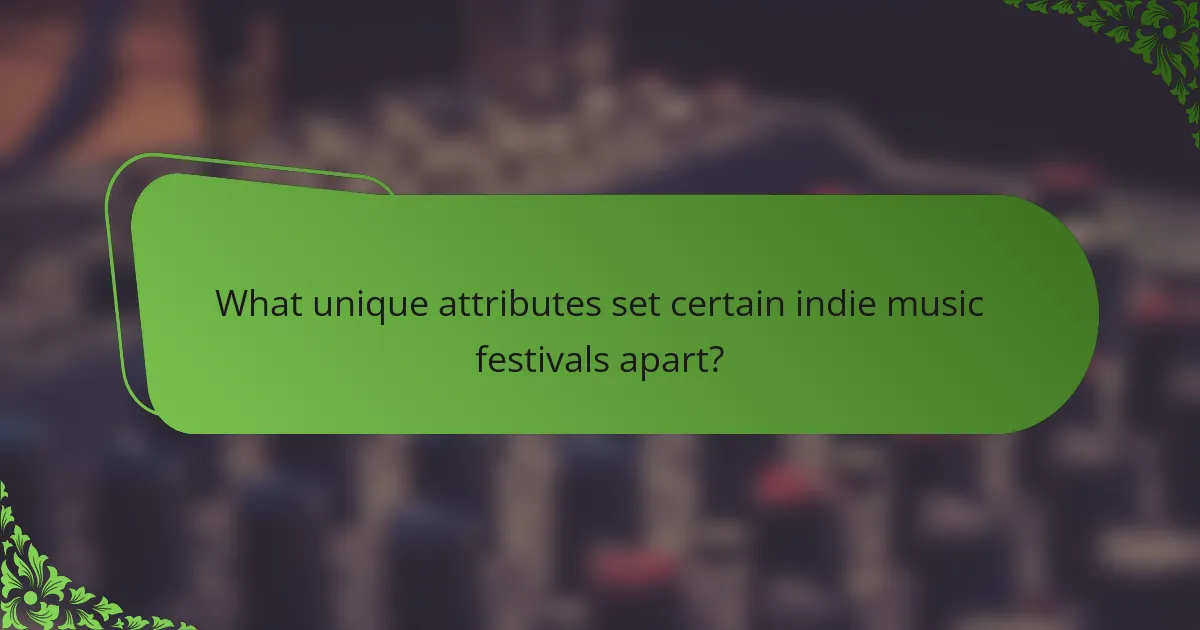
What unique attributes set certain indie music festivals apart?
Unique attributes that set certain indie music festivals apart include their emphasis on local talent, distinct themes, and immersive experiences. Many festivals prioritize community engagement, offering workshops and collaborative opportunities for artists. Additionally, some festivals feature unique locations that enhance the atmosphere, such as outdoor settings or historic venues. These elements create a sense of authenticity and foster deeper connections between artists and audiences, distinguishing them from mainstream events.
How do niche genres influence the character of specific festivals?
Niche genres significantly shape the character of indie music festivals by fostering unique collaborations and enhancing artist exposure. Festivals often curate lineups that reflect specific genres, attracting dedicated audiences and creating a distinct atmosphere.
For instance, folk-focused festivals may emphasize storytelling and acoustic performances, while electronic music festivals prioritize immersive experiences and innovative technology. This specialization allows artists to connect deeply with fans, leading to memorable interactions and potential collaborations.
Moreover, niche genres can influence festival programming, including workshops and panels that explore the cultural significance of the music. These events create opportunities for artists and attendees to engage, share ideas, and build networks within their communities.
As a result, indie music festivals become vibrant hubs where niche genres thrive, promoting artistic diversity and fostering a sense of belonging among attendees.
What innovative formats are emerging in indie music festivals?
Innovative formats emerging in indie music festivals include immersive experiences, hybrid events, and interactive installations. These formats enhance audience engagement and foster collaboration among artists. Immersive experiences, such as themed stages or virtual reality elements, create unique atmospheres. Hybrid events combine live performances with digital streaming, reaching wider audiences. Interactive installations encourage audience participation, transforming spectators into active contributors. These trends reflect a shift towards more dynamic and participatory festival environments.
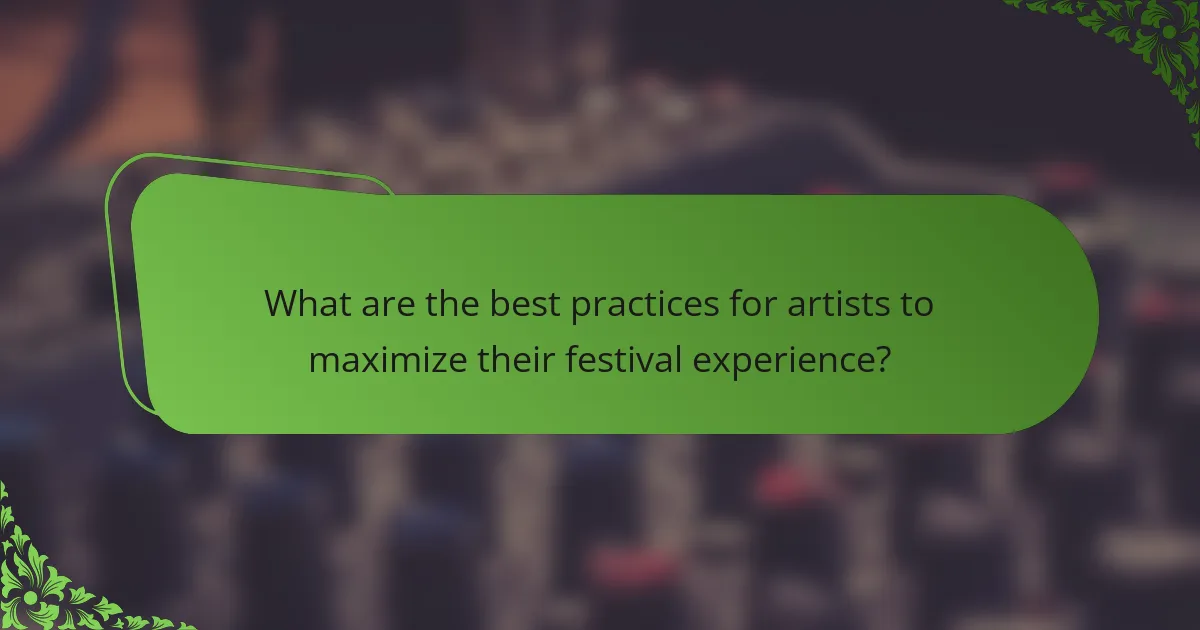
What are the best practices for artists to maximize their festival experience?
Artists can maximize their festival experience by engaging with other musicians, networking with industry professionals, and showcasing their unique sound. Collaborate with fellow artists to create memorable performances. Attend workshops and panels to gain insights into the industry. Use social media to promote your presence and connect with fans. Lastly, prepare a compelling showcase that highlights your distinct style and talents.
How can networking at festivals lead to future collaborations?
Networking at festivals fosters future collaborations by creating connections among artists, industry professionals, and audiences. These events provide informal environments where participants can share ideas, collaborate on projects, and build relationships. Engaging with diverse talents enhances visibility and opens doors to new opportunities. For example, collaborations formed at festivals can lead to joint performances, co-writing sessions, or even record deals. The unique atmosphere of festivals encourages creativity and innovation, making them fertile ground for future partnerships.
What common mistakes should artists avoid when performing at festivals?
Artists should avoid common mistakes like poor preparation, neglecting networking, and ignoring audience engagement. These errors can diminish opportunities for collaboration and exposure at indie music festivals.
First, lack of preparation can lead to missed performance quality. Artists should rehearse thoroughly and ensure their setlist is well-structured.
Second, neglecting networking diminishes potential collaborations. Engaging with other artists, industry professionals, and fans can open doors for future projects.
Lastly, ignoring audience engagement can result in a lackluster performance. Artists should interact with the crowd to create a memorable experience and foster a loyal fanbase.
Which strategies can enhance an artist’s visibility during a festival?
Artists can enhance their visibility during a festival through strategic collaborations and active engagement. Networking with other artists fosters opportunities for joint performances, expanding reach. Utilizing social media platforms effectively can amplify exposure before and during the event. Participating in workshops or panel discussions positions artists as thought leaders, attracting attention. Additionally, creating unique merchandise or interactive experiences draws festival-goers, enhancing memorability. Engaging with local press for interviews or features can further elevate an artist’s profile.
